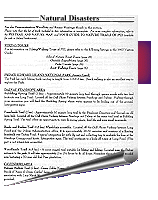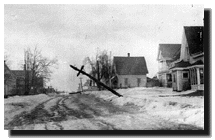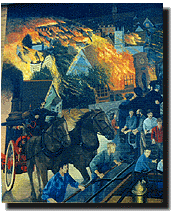
 Thankfully rare events in Island
life, natural disasters are unique occasions that find
Islanders pulling together to help one another through a
difficult time. Living on in our collective memory,
events such as Summerside’s 1906 fire, the West
Prince Fire of 1960 and the Sleet Storm of 1956 are
examples of human resilience and co-operation under
trying circumstances.
Thankfully rare events in Island
life, natural disasters are unique occasions that find
Islanders pulling together to help one another through a
difficult time. Living on in our collective memory,
events such as Summerside’s 1906 fire, the West
Prince Fire of 1960 and the Sleet Storm of 1956 are
examples of human resilience and co-operation under
trying circumstances.
In Summerside, the fire of 1906 is commemorated with an enormous mural displayed on the exterior wall of the fire department building. The blaze that destroyed over 155 buildings is believed to have been ignited by a spark from a train engine at the railway freight shed. Though most of the buildings lost to the fire were residential houses, no lives were lost. Summerside was quickly rebuilt. The homes erected in the aftermath of the fire are a testament, not only to the people’s resilience, but also to the fine architecture of that period.
In the summer of 1960, Prince Edward Island was a tinderbox waiting for a spark. A season of unprecedented drought saw the grass burnt brown and the crops wilting in the fields. Then, on Sunday, August 29, a small forest fire in West Prince that had been silently smouldering for a week went out of control and eventually enveloped a substantial portion of the West Prince area (including areas between Mount Pleasant and Portage north of the Western Road, Port Hill, Foxley River, Springhill, Tyne Valley, Murray Road, Black Banks, and Conway). A day or two later, a gale wind blew up and five families lost their homes. Over the next three weeks, large areas of farms and woodlots were affected by the dozen or so fires that burned at any given time, jumping at random to ignite new areas. On various days, communities and buildings would be threatened, evacuated, and sometimes lost to the fires.
West Prince was like a military zone. The Royal Canadian Air Force in Summerside provided workers and equipment and was later replaced by Canadian Army personnel. Civil Defence personnel and the Canadian Red Cross disaster services also provided support while an army provost blocked off access roads and limited traffic to residents and volunteers. The Legion at Ellerslie was the headquarters of the firefighting effort, where volunteers provided hot meals around the clock. Similarly, the first aid stations were open twenty-four hours a day to provide services and hot lunches. Firefighters from across the Island and Atlantic Canada came to help control the blazes and volunteers from every community in the province gave time and energy to help their neighbours. By the end of the week of September 16, three days of showers and the arrival of Hurricane Donna brought the fires and the danger under control.
 Four years
previous to the fires, a natural occurrence of another
sort caused hardship for the entire area west of
Summerside, including the communities that were to be
affected by the 1960 fires. It took the province two full
months to recover from the two-day sleet storm that began
on Friday, January 6, 1956. Sleet storms are a
particularly unique event in that they occur only when
the temperature hovers within a degree or two of the
freezing point. Slightly warmer temperatures bring rain
and melting; colder temperatures bring snow. By the end
of the two days of freezing sleet, every electrical and
telephone pole between Summerside and Miscouche went
down. Consequently, the entire region west of Miscouche
was in a state of paralysis. Surprisingly, the damage was
much less severe in areas east of Summerside.
Four years
previous to the fires, a natural occurrence of another
sort caused hardship for the entire area west of
Summerside, including the communities that were to be
affected by the 1960 fires. It took the province two full
months to recover from the two-day sleet storm that began
on Friday, January 6, 1956. Sleet storms are a
particularly unique event in that they occur only when
the temperature hovers within a degree or two of the
freezing point. Slightly warmer temperatures bring rain
and melting; colder temperatures bring snow. By the end
of the two days of freezing sleet, every electrical and
telephone pole between Summerside and Miscouche went
down. Consequently, the entire region west of Miscouche
was in a state of paralysis. Surprisingly, the damage was
much less severe in areas east of Summerside.
From Hunter River to Tignish, Maritime Electric had to replace 2,500 poles, causing a shortage of new poles on the Island. Even two weeks after the end of the storm, the communities of Tignish and O’Leary and the Town of Alberton were powered by auxiliary units. Thankfully, the weather remained mild while residents were without electricity. Had our January been its usual blustery cold, many Islanders would have suffered greatly. Miraculously, no deaths were attributable to the storm, although there were some injuries. Full telephone services were not restored until March 5. In total, the storm caused $2.5 million worth of damage to the region.
Erosion | Soil Conservation | Ground Water Quality |
Surface Water Quality | Forestry Practices | Irving Whale
